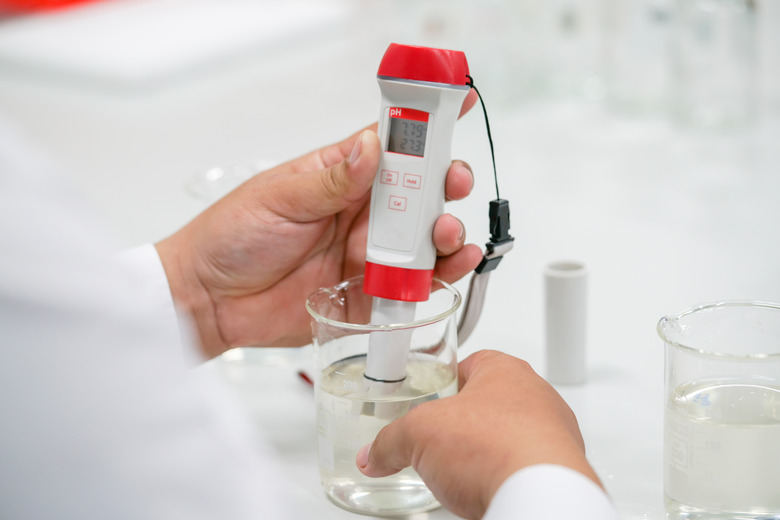The pH Level Of Ammonia
Ammonia is a common liquid used in households and industry, easily identified by its distinctive smell. Many of ammonia's uses and benefits derive from its pH level, which is the measure of how acidic or alkaline (basic) a solution is. The standard pH of ammonia explains many of the properties of the chemical.
TL;DR (Too Long; Didn't Read)
Ammonia is a weak base with a standard pH level of about 11.
pH of Ammonia
pH of Ammonia
One molecule of ammonia consists of one negatively-charged nitrogen ion and three positively-charged hydrogen ions, giving ammonia a chemical formula of NH3. The pH of standard ammonia is about 11.
Features of Ammonia
Features of Ammonia
Ammonia is a base, which means it reacts in water to form a positively-charged ammonium (NH4+) ion and a negatively-charged hydroxide (OH-). As a base, ammonia has a bitter taste (although you should never taste it), a soapy feel and the ability to neutralize acids. Ammonia is a weak base, so it only exhibits the common corrosive effects of many bases when in high concentration.
Formation of Ammonia
Formation of Ammonia
Ammonia occurs naturally and can also be manufactured. Natural ammonia, which exists in trace quantities in the atmosphere, typically comes from the decomposition of organic matter. Most ammonia, however, is created via chemical processes that bond together the nitrogen and hydrogen ions.
Safety Warnings
Safety Warnings
High concentrations of ammonia are extremely dangerous if inhaled, ingested or touched. Ammonia inhalation, which is usually avoidable due to the strong smell, can cause serious respiratory distress. Highly concentrated ammonia can burn the skin or eyes. Treatment involves flushing the affected area with water. If you ingest ammonia, do not induce vomiting but seek medical help immediately. If you use ammonia as a household cleaner, be especially careful to never mix the substance with bleach. A deadly gas called chloramine is the result of such a mixture.
Benefits of Ammonia
Benefits of Ammonia
Ammonia mixes with water and is used in many household cleaners. Most of these cleaners contain between 5 percent and 10 percent ammonia by volume. Commercial cleaners also use ammonia, but the concentrations are much greater, being as high as 25 percent to 30 percent ammonia. Ammonia is also widely used as an ingredient in fertilizers, where it provides nitrogen to the soil. High concentration ammonia is also used to etch metals and provide commercial refrigeration.
Cite This Article
MLA
Brown, Laurel. "The pH Level Of Ammonia" sciencing.com, https://www.sciencing.com/ph-level-ammonia-5505219/. 14 May 2018.
APA
Brown, Laurel. (2018, May 14). The pH Level Of Ammonia. sciencing.com. Retrieved from https://www.sciencing.com/ph-level-ammonia-5505219/
Chicago
Brown, Laurel. The pH Level Of Ammonia last modified March 24, 2022. https://www.sciencing.com/ph-level-ammonia-5505219/
